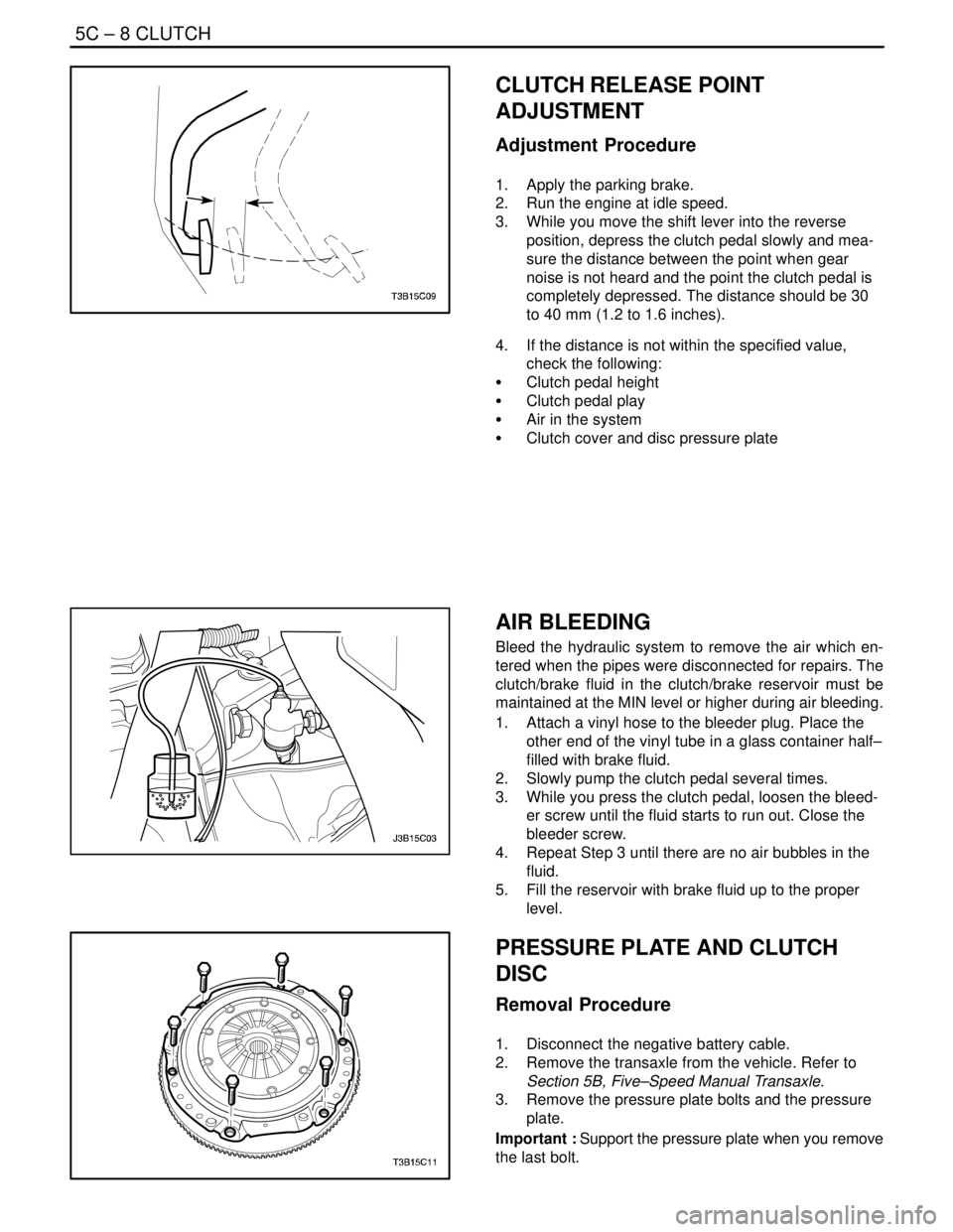Page 1850 of 2643
5B – 26IFIVE–SPEED MANUAL TRANSAXLE
DAEWOO V–121 BL4
UNIT REPAIR
MAJOR COMPONENT DISASSEMBLY
Tools Required
J–6125–B Slide Hammer
J–22888–20–A BearingPuller with J–22888–35 Puller
Legs
KM–553–A Fifth Gear Puller
J–36633 Snap Ring Retainer
KM–113–2 Base
J–42469 Shift Rod Remover
KM–552 Fixture
Disassembly Procedure
1. Remove the transaxle from the vehicle. Refer to
”Transaxle Assembly” in this section.
2. Remove the filler plug at the cover.
3. Remove the bolts from the gearshift lever cover.
4. Remove the gearshift lever cover.
Page 1851 of 2643
FIVE–SPEED MANUAL TRANSAXLE 5B – 27
DAEWOO V–121 BL4
5. Bolt the gearshift lever cover to the fixture KM–552.
6. Position the fixture KM–552 into the base
KM–113–2.
7. Remove the snap ring, the bushing, the spring, and
the intermediate lever.
8. Remove the shift finger lever pin.
9. Remove the gearshift rod and the shift finger lever.
Page 1858 of 2643
5B – 34IFIVE–SPEED MANUAL TRANSAXLE
DAEWOO V–121 BL4
36. Remove the fifth gearshift lever from the bearing
plate.
37. Remove the first–second gearshift rod.
38. Compress the snap ring holding the mainshaft and
secure it with the snap ring retainer J–36633.
39. Hold the snap ring open at the base of the input
shaft using the snap ring pliers.
40. Remove the mainshaft assembly and the input
shaft assembly from the bearing plate.
Page 1874 of 2643
5B – 50IFIVE–SPEED MANUAL TRANSAXLE
DAEWOO V–121 BL4
7. Install the transaxle cover and the transaxle cover
bolts.
Tighten
Tighten the transaxle cover bolts to 18 NSm (13 lb–ft).
8. Install the gearshift lever cover and the gearshift
lever cover bolts.
Tighten
Tighten the gearshift lever cover bolts to 22 NSm (16
lb–ft).
9. Install the transaxle into the vehicle. Refer to
”Transaxle Assembly” in this section.
DIFFERENTIAL
Tools Required
KM–520 Remover/Installer
KM–525 Installer
J–22888–20–A Bearing Puller with J–22888–35 Puller
Legs
KM–522 Installer
Disassembly Procedure
1. Remove the differential cover bolts, the differential
cover, and the differential cover gasket.
2. Remove the bearing–adjusting ring retainer plate
bolt and the bearing–adjusting ring retainer plate.
Page 1880 of 2643
5B – 56IFIVE–SPEED MANUAL TRANSAXLE
DAEWOO V–121 BL4
13. Install the differential cover gasket, the differential
cover, and the differential cover bolts.
Tighten
Tighten the differential cover bolts to 40 NSm (30 lb–
ft).
MAJOR COMPONENT ASSEMBLY
Tools Required
J–36633 Snap Ring Retainer
KM–334 Installer Sleeve
KM–552 Fixture
KM–554 Installer
KM–113–2 Base
Assembly Procedure
1. Join the mainshaft and the input shaft.
2. Compress the snap ring at the base of the main-
shaft and hold with the snap ring retainer J–36633.
3. Hold the snap ring at the base of the input drive-
shaft with the snap ring pliers.
4. Install the mainshaft/input shaft assembly onto the
bearing plate.
5. Release the mainshaft snap ring and the input shaft
snap ring.
6. Position the first–second gearshift fork.
7. Install the fifth gearshift lever into the bearing plate.
Page 1886 of 2643
5B – 62IFIVE–SPEED MANUAL TRANSAXLE
DAEWOO V–121 BL4
31. Bolt the gearshift lever cover to the fixture KM–552.
32. Position the fixture into the base KM–113–2.
33. Install the gearshift rod, the shift finger lever, and
the gearshift lever pin.
34. Install the snap ring, the bushing, the spring, and
the intermediate lever.
35. Remove the gearshift lever cover from the base
KM–113–2 and the fixture KM–552.
36. Shift the transaxle into NEUTRAL.
37. Install the gearshift lever cover and the gearshift
lever cover bolts.
Tighten
Tighten the gearshift lever cover bolts to 22 NSm (16
lb–ft).
38. Install the transaxle cover and the transaxle cover
bolts.
Tighten
Tighten the transaxle cover bolts to 18 NSm (13 lb–ft).
39. Install the transaxle into the vehicle. Refer to
”Transaxle Assembly” in this section.
Page 1895 of 2643

5C – 8ICLUTCH
DAEWOO V–121 BL4
CLUTCH RELEASE POINT
ADJUSTMENT
Adjustment Procedure
1. Apply the parking brake.
2. Run the engine at idle speed.
3. While you move the shift lever into the reverse
position, depress the clutch pedal slowly and mea-
sure the distance between the point when gear
noise is not heard and the point the clutch pedal is
completely depressed. The distance should be 30
to 40 mm (1.2 to 1.6 inches).
4. If the distance is not within the specified value,
check the following:
S Clutch pedal height
S Clutch pedal play
S Air in the system
S Clutch cover and disc pressure plate
AIR BLEEDING
Bleed the hydraulic system to remove the air which en-
tered when the pipes were disconnected for repairs. The
clutch/brake fluid in the clutch/brake reservoir must be
maintained at the MIN level or higher during air bleeding.
1. Attach a vinyl hose to the bleeder plug. Place the
other end of the vinyl tube in a glass container half–
filled with brake fluid.
2. Slowly pump the clutch pedal several times.
3. While you press the clutch pedal, loosen the bleed-
er screw until the fluid starts to run out. Close the
bleeder screw.
4. Repeat Step 3 until there are no air bubbles in the
fluid.
5. Fill the reservoir with brake fluid up to the proper
level.
PRESSURE PLATE AND CLUTCH
DISC
Removal Procedure
1. Disconnect the negative battery cable.
2. Remove the transaxle from the vehicle. Refer to
Section 5B, Five–Speed Manual Transaxle.
3. Remove the pressure plate bolts and the pressure
plate.
Important : Support the pressure plate when you remove
the last bolt.
Page 1903 of 2643

6A – 2IPOWER STEERING SYSTEM
DAEWOO V–121 BL4
DIAGNOSIS
POWER STEERING SYSTEM
PRESSURE TEST
Tools Required
KM–354–B Pressure Test Gauge Kit
Check the fluid pressure as follows to determine whether
the trouble is in the pump or the gear unit.
Test Procedure
1. Check the power steering fluid level and the power
steering pump belt tension. Refer to ”Checking and
Adding Fluid” in this section and Section 6B, Power
Steering Pump.
2. Disconnect the high pressure line at the pump. Use
a small container to catch any fluid.
3. Connect the hose of the pressure test gauge kit
KM–354–B to the power steering pressure hose
from the power steering pump.
4. Place the gear selector lever in PARK (automatic
transaxle–equipped vehicles) or NEUTRAL (manual
transaxle–equipped vehicles). Set the parking
brake.
5. Open the gauge valve fully.
6. Start the engine and let it idle.
7. Turn the steering wheel from lock to lock several
times to warm the fluid to operating temperature.
8. Increase the engine speed to 1,500 rpm.
Notice : The power steering pump could be damaged if
the valve is fully closed for more than 5 seconds.
9. Close the gauge valve fully, and read the pressure.
The pump pressure with the valve closed should be
between 8,330 kPa to 8,820 kPa (1,208 psi to
1,279 psi). With electronic variable orifice, the pres-
sure should be between 8,500 kPa to 8,960 kPa
(1,233 psi to 1,299 psi).
10. Immediately open the gauge valve fully.
11. Turn the steering wheel all the way to the left and
the right. If the pressure is within the specified lim-
its, the problem is not in the pump. Check the pow-
er steering gear for leaks.
POWER STEERING SYSTEM LEAK
TEST
General Procedure
Inspect the following:
S The fluid reservoir for overfill.
S Fluid for aeration and overflow.
S The hoses for loose connections.
S The torsion bar, stub shaft and adjuster seals for
leaks.
S The component sealing surfaces for damage.
Important : Verify the exact point of the leak. The point
from which the fluid is dripping is not necessarily the point
at which the system is leaking. When service is required,
clean the leak area upon disassembly, replace the leaking
seal, check the component sealing surfaces for damage
and reset the torque bolt to specifications, where required.
External Leak Check
The purpose of this procedure is to pinpoint the location of
the leak. In some cases, the leak can be easily located, but
seepage–type leaks may be harder to find. To locate seep-
age leaks, use the following method:
1. With the engine off, wipe dry the complete power
steering system.
2. Check the power steering fluid level in the pump’s
reservoir. Adjust the fluid level as necessary. Refer
to ”Checking and Adding Fluid” in this section.
Notice : Do not hold the steering wheel at a stop for any
length of time as this can damage the power steering
pump.
3. Start the engine. Turn the steering wheel counter-
clockwise and clockwise from stop to stop several
times.
4. Find the exact area of the leak and repair it.